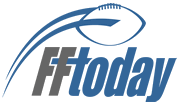|
Fantasy Football Strategy, Advice, and Commentary |
|

 By: Doug Orth — April 24, 2013 @ 9:36 am By: Doug Orth — April 24, 2013 @ 9:36 am
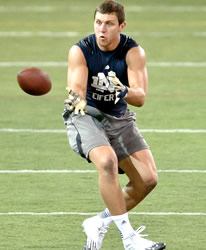 Eifert is the consensus top tight end in the 2013 draft. Vitals
Height/Weight: 6’6”/251
Hands: 9 1/8”
Important NFL Combine Numbers
40-Yard Dash: 4.68
Vertical Jump: 35 1/2”
Broad Jump: 9’ 11”
20-Yard Shuttle: 4.32
Background (College Stats)
The son of a former Purdue basketball player, Eifert began to emerge as a factor in Notre Dame’s offense in 2011 when he led all FBS tight ends with 63 receptions for 803 yards as a complement to first-round receiver Michael Floyd. Eifert was not highly recruited out of high school, but ended his amateur career as a two-time finalist for the John Mackey Award (college football’s best tight end) and won it this past season despite seeing his numbers slip to 50 catches for 685 yards. Despite leaving college a year early, Eifert leaves Notre Dame with just about every school receiving record for a tight end – including catches (140) and receiving yards (1,840).
NFL Player Comp(s): Ed McCaffrey
This requires a bit of an explanation since McCaffrey was a receiver for three teams from 1991-2003. The best current player comp is probably the Carolina Panthers’ Greg Olsen, but I was less than two minutes into studying Eifert recently before my mind flashed to “Easy Ed”. Despite being 35 pounds heavier, Eifert actually has a similar body type to McCaffrey. However, the comparison stems from the fact that both players use(d) their size, grit and fearlessness to do most of their damage as a receiver.
Strengths
Eifert may have no peers in his class – at tight end or receiver – when it comes to focus and body control. There also may be no pass catcher in this draft that attacks the ball in the air better than he does or shows less regard for his own physical well-being when he leaves the ground. Despite somewhat less-than-ideal hand size, Eifert helps make up for it with superior hand strength. The 2012 Mackey Award winner has a lean, long frame with above-average arm length (33 1/8”), which he uses to “box out” defenders in zone coverage. Notre Dame used him all over the field, which speaks to his versatility and ability to understand the entire offense (and not just his role in it). Eifert is a feisty competitor, which was reflected in the desire he showed when trying to power through a tackle or when he made a block for a ball-carrier down the field to prolong a big play. Eifert was plenty productive at Notre Dame despite the lack of a consistently accurate quarterback, improved dramatically over his college career and has no red flags attached to him on or off the field.
Weaknesses
Almost every college prospect can improve their route-running ability and Eifert is no different, with his biggest issue being that he telegraphed too many of his routes. When combined with his lack of initial burst, Eifert may struggle to consistently beat man coverage in the early part of his career. While he will create big plays with his ability to win jump balls, he isn’t likely to gain many yards after the catch. Like most young tight ends, Eifert’s effort as a blocker is ahead of his effectiveness, although that is a weakness many tight ends have been able to overcome in the NFL once they add “man-muscle”, learn the proper angles and make football their full-time job. It’s the same lack of overall strength that will probably limit his snap count in his first year or two in the NFL and prevent him from getting open against some of the league’s better cover linebackers early in his career.
Bottom Line
Although the Irish didn’t really have many other legitimate passing-game weapons to threaten Alabama’s defense in the BCS National Championship game, it was telling that Crimson Tide coach Nick Saban opted to use CB Dee Milliner against him in coverage and even more telling that Notre Dame QB Everett Golson seemingly forced the ball to him anyway. Like most of this year’s prospects, I don’t get the sense that Eifert will be that once-in-a-decade (or generation) talent that defines this draft class. However, I do think he will be a better all-around pro than last year’s top-drafted tight end, Coby Fleener. Assuming Eifert continues to show the same kind of work ethic and year-to-year improvement he displayed in college at the next level, none of his current shortcomings should be overly difficult to overcome. In a day and age where most tight ends are strictly “rocked-up receivers” or muscle-bound in-line blockers, Eifert is the exception and projects a player who should eventually excel at receiving and blocking. While it is important to note that the Golden Domer isn’t likely to become the next Jimmy Graham, Rob Gronkowski or Tony Gonzalez, Eifert could easily evolve into a top 10 player at his position and make multiple Pro Bowls in the right system with a quarterback who learns to trust his ability to make the contested catch.
 By: Doug Orth — April 23, 2013 @ 9:13 am By: Doug Orth — April 23, 2013 @ 9:13 am
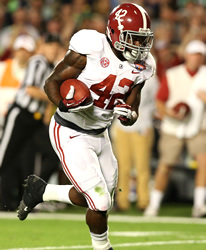 The most powerful RB in the draft. Vitals
Height/Weight: 5’11/231
Hands: 9 1/2”
Important Pro Day Numbers (NFL Combine – DNP; hamstring)
40-Yard Dash: 4.64
Vertical Jump: 33 1/2”
Broad Jump: NA
20-Yard Shuttle: NA
Background (College Stats)
A four-star recruit despite playing only seven games in his final year of high-school football in Louisiana, Lacy is just the latest in what is becoming a long line of first-round quality NFL running backs from the University of Alabama. (Mark Ingram went in the first round in 2010, Trent Richardson went No. 3 overall in 2012 and freshman T.J. Yeldon projects as a high future first-rounder himself.) Lacy overcame a tough upbringing, including but not limited to being displaced by Hurricane Katrina as a teenager. Although he was never the featured back at Alabama, he accepted his role as a complementary back and played a critical role in two of the school’s three national championships over the past four seasons.
NFL Player Comp(s): Andre Brown
Strengths
Lacy is without question the most powerful back in this draft, faster and more athletic than most would expect a back his size to be. Unlike many draft-eligible running backs, he is already where he needs to be in terms of his build, meaning his transition to the NFL will almost exclusively be above the shoulders. And unlike most runners his size, he is not strictly a straight-line runner. But perhaps the most surprising part of his game is his spin move – which he will utilize multiple times per game – underscoring the fact he is not just a big back, but one that is light on his feet with very good balance. The first-team All-SEC selection is also not one of those big backs seems to embrace contact and will fight for every yard. For a player who runs as violently as Lacy does, the fact that he wasn’t worn down (355 carries in three years at Alabama) in college makes him more attractive to talent evaluators. Vision and patience are underrated parts of Lacy’s game as he does a good job of pressing the hole and bursting through it when it develops. Those skills – along with his one-cut ability – make him a more than adequate fit as a back in the zone-blocking offense while his size and tendency to break through weak tackle attempts should allow him to hold up well in a power-based run-blocking scheme. Lacy is also a willing and improving pass blocker, meaning he isn’t likely to embarrass himself in those situations.
Weaknesses
Foot injuries (ankle sprains, turf toe) were a slight concern in college, which made his durability a question mark before the draft process began. He then suffered a partial hamstring tear during pre-draft training, causing further anxiety. His willingness to accept contact also likely means he will struggle to remain healthy enough to stack consecutive 16-game seasons together. While it is always hard to knock a runner during an evaluation for playing with superior offensive line talent, Lacy rarely ever had to dodge a defensive tackle or linebacker penetrating the line of scrimmage because it rarely ever happened. (Consider this aspect of his game more of an unknown than a weakness at this point, but it needs to be pointed out that big backs are typically more dependent on their lines to hold the point because it takes them a split second more to build up their speed and get to the hole in order to create the momentum necessary to power through the linebacker or safety.) Lacy has adequate hands, but it is doubtful he’ll ever emerge as anything more than a dump-off or screen option simply because he isn’t sudden enough nor does he run the sharp routes necessary to free himself.
Bottom Line
(To give readers some idea on how I would rank the recent Tide runners in terms of pro potential, I would go Richardson-Yeldon-Lacy-Ingram.) Critics of Lacy may point out that he was rarely the best back in his own backfield, but talent evaluators – or at least the good ones anyway – recognize that Alabama simply has enjoyed an embarrassment of riches at the position. While I must admit I was turned off by his answer to a question he received on his pro day (he suggested the reason he couldn’t make it through his workout was because he didn’t eat enough prior to the workout), it is hard to knock the way he closed out his college career. If he had only managed to perform at that level for his entire junior season, my final assessment of him might be different. Lacy projects as a player that should have an immediate impact as a red-zone/bruiser/end-of-game role, similar to the role the Detroit Lions had in mind for Mikel Leshoure before the start of the 2012 season. While Lacy is unlikely to be a bust simply because he has what a lot of teams want – power – I also don’t see anything about his game that screams “must-have” either.
 By: Doug Orth — April 22, 2013 @ 12:38 am By: Doug Orth — April 22, 2013 @ 12:38 am
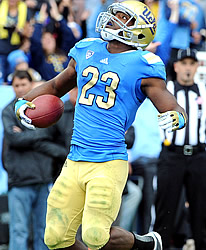 “Elite” status may be out of the question for Franklin. Vitals
Height/Weight: 5’10/205
Hands: 9 1/8”
Important NFL Combine Numbers
40-Yard Dash: 4.49
Vertical Jump: 31”
Broad Jump: 9’ 7”
20-Yard Shuttle: 4.31
Background (College Stats)
Franklin didn’t enter college football with all that much fanfare (a three-star recruit) and redshirted in 2008 before emerging as a four-year starter for UCLA. Although he began to show his wares as a sophomore in 2010 with his first 1,000-yard rushing season, it really wasn’t until the arrival of new coach Jim Mora Jr. and offensive coordinator Noel Mazzone that Franklin truly entered the conversation as an upper-echelon first- or second-day running back. In Mazzone’s zone-read offense, Franklin produced back-to-back 200-yard games against Rice and Nebraska in 2012 that generated early Heisman Trophy buzz. Perhaps most amazingly, Franklin set single-season records for rushing yards (1,734) and all-purpose yards (2,062) as well as career marks for rushing (4,403) and all-purpose yards (4,920) for a Bruins team that went 26-27 during his four-year stay.
NFL Player Comp(s): Warrick Dunn / Shane Vereen
Strengths
Franklin has the tools necessary to excel in the zone-running scheme that just about every team uses to a degree and some teams feature. He runs bigger than most backs his size, is patient and willing to run inside. He also ranks among the best in this class in terms of his vision and has the balance necessary to not get knocked off his feet in the hole. Although he won’t make his living by generating yards after contact, he does a fine job of keeping his legs moving and falling forward. Along with his vision, his best attributes may be his cutting ability and explosion, the three traits that will likely be how he makes a name for himself in the NFL. Toughness and durability are two other traits that Franklin has displayed that are somewhat uncommon for a player his size. Mazzone’s offense accentuated his ability to catch the ball and excel in the open field as the Bruins frequently used him on swing passes to get him on the perimeter of the defense. Franklin didn’t get a chance to showcase his receiving ability for much in his career, but his senior tape proves it wasn’t because of a lack of skill. Ball security had been an issue throughout his first three years, but he did a much better job of holding onto the ball in 2012. Intangibles – such as leadership, work ethic, work in the community, etc. – are also not in question.
Weaknesses
Two of the primary concerns entering the 2012 season – ball handling and picking up the blitz – will remain his biggest question marks entering his rookie season, until he can prove that he can do it again. (It should be noted that he had zero fumbles in 2012, showed dramatic improvement as a pass blocker and backed the latter up with a solid performance during Senior Bowl week.) Franklin knows he is at his best outside the hashes and bounces a few too many runs to the perimeter, although that is not an uncommon thing for any college back that has enjoyed as many big plays in his career as Franklin has. While the second-team All-American can make defenders miss in the open field, he isn’t exactly a player that will stack one open-field move on top of another. Franklin has likely already maxed out his frame, meaning he probably isn’t going to add 10 pounds without sacrificing a few of his aforementioned strengths. Given how NFL teams have taken the bigger-is-better approach in short-yardage situations, Franklin probably won’t see a great deal of time on the field in at the goal line.
Bottom Line
Mora is said to love Franklin more than Dunn, who he coached for several years with the Atlanta Falcons, and it is a very appropriate comparison to make – on and off the field. Franklin isn’t likely to get a lot of action in the red zone in the NFL, although he wasn’t exactly a slouch in that department in college. (Remember, Dunn lost a lot of those opportunities to T.J. Duckett even though Dunn was the better inside/goal-line back.) While I don’t believe Franklin will ever be an “elite” back, I have little doubt he can emerge as a 250-carry back at some point early in his career. He doesn’t take a lot of big hits and has shown the ability to make dramatic improvements from one season to the next, suggesting he cares about his craft and wants to be great. Franklin has also drawn comparisons to Frank Gore (minus the catastrophic knee injuries), Bernard Scott and Maurice Jones-Drew – a fellow UCLA alum. While none of those comparisons are completely off, he’s almost certain to be viewed by coaches as a 1A/1B kind of back (as opposed to “featured” back), which brings us back to Dunn and Vereen. Franklin should be a solid, steady 6-7 year pro that averages about 220 touches.
 By: Dave Stringer — April 5, 2013 @ 9:11 am By: Dave Stringer — April 5, 2013 @ 9:11 am
Having refused to accept a reduction in his 2013 salary as an Oakland Raider, quarterback Carson Palmer was traded yesterday to the Arizona Cardinals.
As part of the trade, the Cardinals sent a high sixth-round pick in this year’s draft to Oakland in exchange for the Raiders seventh-round pick, a swap that allows Oakland to move up 43 places in the draft. In addition, the Cardinals will give up a 2014 seventh-round pick if Palmer starts 13 games in 2013.
After Palmer refused a pay cut, the Raiders traded for Seahawks backup Matt Flynn, effectively ending Palmer’s two-year run as the team’s starter. His acquisition from the Bengals in 2011 will go down as one of the Oakland’s worst trades ever, with the Raiders having given up first- and second-round picks for a quarterback who started just 24 games for them.
After struggling somewhat in 2011, Palmer enjoyed a solid season in 2012, completing 61.1% of his passes for 4,018 yards with 22 touchdowns and 14 interceptions.
In Arizona, Palmer ascends to the top of the team’s depth chart with recent free agent signee Drew Stanton entrenched as the team’s top backup. John Skelton, who started 17 games during his first three seasons in the league, was released.
Fantasy Impact
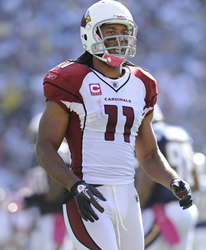 Fitz may flirt with the fantasy top ten with Palmer under center. Cardinals fans want to know, is Palmer the second coming of Kurt Warner? In short, no. He’s not as accurate as Warner, he doesn’t read defenses as well, and he hasn’t enjoyed any playoff success prior to coming to the desert.
The biggest winner with this trade from a fantasy perspective is Cardinals wide receiver Larry Fitzgerald.
Last season Fitzgerald caught just 71 passes for 798 yards (the second lowest total of his career) and four touchdowns (the lowest of his career). Any casual fan could tell you that his production suffered due to the shoddy play of the team’s quarterbacks, and a quick glance at his catch-to-target percentage confirms that (71 receptions on 156 targets for a 45.5% completion percentage).
If Skelton and Kevin Kolb, with perhaps a rookie draft pick, were atop the depth chart to open next season, Fitzgerald would have ranked as a low-end WR2.
With Palmer under center, Fitzgerald becomes a low-end WR1. Having a quarterback with the arm strength, accuracy and experience to execute new head coach Bruce Arians’ downfield passing attack should do wonders for Fitzgerald’s fantasy value.
Of course, downfield passing attacks flounder under the weight of a poor offensive line, and that is an issue the Cardinals must address prior to the start of the season. They led the league in sacks allowed last season, and Palmer is about as stationary a quarterback as you will find in the league, though he is effective at reading defenses and getting the ball out on time.
Look for the Cardinals to use the seventh overall selection to address the offensive tackle position. with Bobby Massie, last season’s starter at right tackle, a candidate to move inside to guard.
Wide receivers Michael Floyd, a 2012 first-round pick, and Andre Roberts will also benefit with Palmer at the controls. Floyd has plenty of upside and Roberts has improved his reception and yardage totals in each of his three years in the league. However, both will rate as fantasy backups until they prove otherwise.
Running back Rashard Mendenhall also sees a boost in his fantasy appeal, as he figures to face fewer eight- and nine-man fronts with a quality veteran at quarterback. He shapes up as an upper-tier fantasy backup with upside entering 2013.
As for Palmer, feel comfortable grabbing him as your fantasy backup at QB—a mid- to upper-tier one at that.
 By: Doug Orth — March 29, 2013 @ 10:18 am By: Doug Orth — March 29, 2013 @ 10:18 am
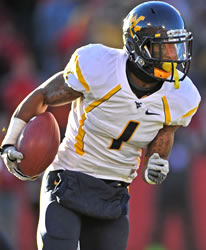 Austin: The next Randall Cobb? Vitals
Height/Weight: 5’8/174
Hands: 9 1/8”
Important NFL Combine Numbers
40-Yard Dash: 4.34
Vertical Jump: 34”
Broad Jump: 10’
20-Yard Shuttle: 4.01
Background (College Stats)
A two-time Maryland high school player of the year that set a number of state career and single-season records, Austin led the NCAA in all-purpose yards as a junior (198/game) and finished second in the category as a senior (224.4). Austin was already in consideration to be a potential late-first or early-second round draft pick midway through last season, but likely solidified his standing as a top-20 selection with a historic performance against Oklahoma on Nov. 17, 2012. In that contest, Austin – a wide receiver who had no more than five carries in any of his first 48 career games – rushed 21 times for a school-record 344 yards in his first action at running back since high school and set a Big 12 record with 572 all-purpose yards. As a result of his stellar senior season, Austin won the Paul Hornung Award (most versatile player) and earned first-team All-America honors as an all-purpose player.
NFL Player Comp(s): Randall Cobb / T.Y. Hilton
Strengths
Austin combines incredible acceleration with breathtaking quickness, allowing him to be the kind of “space player” the NFL has found a role for in recent years. Perhaps the one aspect of his game that really jumps off the tape is his stop-and-start ability which – when combined with his body control and vision in the open field – allows him to create a lot of “whiffs” and make defenders look silly. These same qualities obviously bode well for his chances to be one of the NFL’s top kickoff and punt returners – areas in which he excelled in college. While his size will likely always be an issue, defenders rarely get a chance to square up Austin – particularly in the open field – and, as such, he never missed a practice or game at West Virginia. That quality, along with the fact that he plays to his timed speed, should help quickly dissolve the notion that he is a slot-only receiver with return skills. Austin gains separation rather easily, has a solid feel for the soft areas in zone coverage and transitions out of cuts effortlessly. Although he wasn’t used much as a deep threat in college, he certainly has the ability to do that and will fight for the ball in the air.
Weaknesses
Size – and how it relates to his ability to absorb punishment in the NFL – is probably always going to be the biggest question mark with Austin. He isn’t the most consistent “hands-catcher” and will drop balls that he should catch. On the rare occasion that he can’t make a defender miss, he tends to get tripped up easier than he should. Austin often plays as if he has gotten used to defenders being unable to corral him – which could easily come back to haunt him at the next level. His vertical jump is average for a receiver – which accentuates his lack of height even more – meaning quarterbacks probably won’t throw to him as much down the field despite his top-end speed unless he has at least a step or more on his defender.
Bottom Line
Austin isn’t built in the same way Percy Harvin is – and probably never will be – which will likely result in him being used slightly less on offense than he should be, at least initially. The upside for his future employer is that while he may only see 30-40 snaps on offense per game in his first season or two, his contributions as a returner may help make for it. In that way, it is entirely possible that his career trajectory is similar to Cobb’s in which he essentially forces his way into the starting lineup in Year 2 simply because he will prove to be his team’s most explosive playmaker. As is usually the case with a young skill-position player entering the league, the creativity, aggressiveness and scheme of the offense he enters will have a big say in his overall production. His best fit will likely be in a wide-open passing offense that uses him all over the field and isn’t scared of how someone of his size will hold up long-term. Austin projects better to the NFL than a similar-sized player such as Dexter McCluster simply because he is more elusive and explosive. While Austin could line up in the backfield in theory to dictate defensive personnel, it would be a mistake for his future team to put him in a position where he may be forced to run in between the tackles. Austin is a slot receiver that should hold his own on the outside in two-receiver packages and contribute as a returner, not a receiver that should be asked to serve in a third-down back role at any cost.
 By: Mike Krueger — March 16, 2013 @ 9:35 am By: Mike Krueger — March 16, 2013 @ 9:35 am
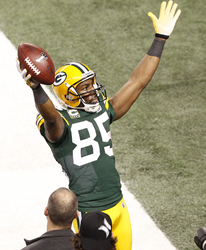 Jennings gives Ponder a legitimate weapon on the outside. Following the path of other ex-Packers (QB Brett Favre, K Ryan Longwell, S Darren Sharper), wide receiver Greg Jennings tested the free agent market and found a home in Minnesota.
Jennings signed a five-year, $47.5 million deal with the Vikings worth roughly $27 million over the first three years. His contract comes in below deals recently signed by Mike Wallace (5 years $60 million) and Dwayne Bowe (5 years, $56 million) but substantially above Wes Welker’s agreement in Denver (2 years, $12 million).
Minnesota had little choice but to sign Jennings after trading away their main receiving threat, Percy Harvin, to the Seahawks in exchange for draft picks. Jerome Simpson was resigned earlier this week but given the lack of talent in the receiving corps it won’t come as a surprise if the Vikings use one of their two first-round draft picks (#23 & #25) on a receiver.
Fantasy Impact
The 29 year-old Jennings appeared in eight games last year due to injury and turned in his worst season as a pro (36 rec, 366 yds, 4 TDs). He fills a gaping hole in the Vikings offense and has the ability to play on the outside or in the slot. Regardless of any moves at the receiver position yet to come, he will be the focus of the passing attack.
An attack led by Christian Ponder, not Aaron Rodgers.
Ponder and the Vikings passing offense won’t be confused the Packers aerial assault anytime soon. Minnesota ranked 31st in passing yards last season and with Ponder averaging 6.1 yards per attempt (31st also), Jennings could catch 90 balls and not break 1000 yards. And do forget, the offense runs through Adrian Peterson and their run-first philosophy won’t change anytime soon.
It’s not all doom and gloom however, as Jennings would be one of many mouths to feed in Green Bay as Randall Cobb, James Jones, Jordy Nelson and TE Jermichael Finley are very deserving of targets… and will get them. In Minnesota, Jennings will be the big fish in the purple pond but will have a hard time cracking WR1 territory without significant improvement from QB Christian Ponder and the Vikings demonstrating a willingness to open up the offense.
In the end, this likely is a neutral move for Jennings’ fantasy value, representing as a low-end WR2 with very little upside due to below average quarterback play.
 By: Dave Stringer — March 15, 2013 @ 10:07 am By: Dave Stringer — March 15, 2013 @ 10:07 am
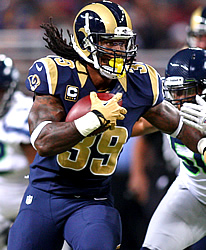 The Falcons have themselves a workhorse at running back. With a gaping hole at running back following the release of Michael Turner, the Atlanta Falcons have landed the top free agent at the position in former Ram Steven Jackson.
Reports indicate that Jackson will sign a three-year, $12 million contract.
Atlanta’s interest in Jackson was perhaps the league’s worst kept secret entering the free agency period. It is likely that only the lukewarm interest Jackson received from the Green Bay Packers kept him from agreeing to terms with Atlanta earlier.
In the 29-year-old Jackson, the Falcons gain a player long considered one of the league’s premier power running backs and perhaps the most consistent player at his position, as evidenced by his eight consecutive 1000-yard seasons. In 2012, he gained 1,042 rushing yards and scored four touchdowns while averaging 4.1 yards per carry. He also chipped in 38 receptions for 321 yards.
With Jackson on the roster, third-year player Jacquizz Rodgers will remain the team’s top backup, with Jason Snelling providing additional depth.
Fantasy Impact
Jackson has ranked as the 17th, 11th and 14th fantasy RB in the past three years, as his low touchdown totals (4, 6, and 6, respectively) have held his ranking down.
In Atlanta, with one of the league’s leading offenses, Jackson figures to approach the 11 touchdowns Turner scored in 2012, meaning the only issues that could prevent Jackson from being a lower-tier RB1 in 2013 are injuries (two missed games over the last four years) and a decline in performance.
While Jackson will hit the dreaded 30-year-old mark prior to the season and has accumulated 2,395 rushing attempts and 407 receptions over his nine-year career, his performance in 2012 was not indicative of a player on the downside of his career.
His yards per carry was a respectable 4.1 (just off his career average of 4.2) and he caught 38 passes, making it the eighth straight year he has caught at least that many, while averaging 8.4 yards per reception. With Roddy White, Julio Jones and Tony Gonzalez around to keep opposing defenses honest, Jackson won’t face the eight- and nine-man fronts he saw during most of his tenure in St. Louis.
In an era dominated by the running-back-by-committee approach, Jackson bucked that trend as a true workhorse during his stay with the Rams. However, with Rodgers in tow as his backup, and worthy of 8 to 10 touches per game, Jackson is likely in line for 250 to 280 touches in 2013. That should make him an upper-tier RB2 with an outside chance of low-end RB1 production. Rodgers is a solid handcuff and decent flex option in 12-team leagues.
Falcons quarterback Matt Ryan gains another option in the passing game (Turner had a career-high 19 receptions in 2012), which should add to his production. He remains just outside of the big four at quarterback.
Jackson’s presence has little to no impact on White, Jones and Gonzalez.
 By: Dave Stringer — March 14, 2013 @ 9:04 am By: Dave Stringer — March 14, 2013 @ 9:04 am
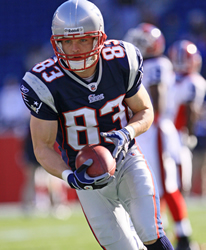 Wes Welker moves from Hall of Fame QB to another. In one of the more stunning free agent signings in recent years, Wes Welker has agreed to terms with the Denver Broncos.
Unable to reach a deal with New England after playing the 2012 season under the franchise tag, Welker chose to leave the Patriots and end his longstanding and productive relationship with quarterback Tom Brady to sign with the Broncos, where he will join Peyton Manning.
In an era of ever-churning news cycles, Welker’s decision to leave New England for Denver will be debated for a long time, particularly given that he agreed to a modest deal (reportedly two years and $12 million) shortly after Brady signed a below-market extension that granted the Patriots an abundance of salary cap space.
Brady’s reaction to the deal will be almost as interesting as watching Welker on the field in Denver with Manning.
Regarded as the league’s premier slot receiver, Welker recorded 672 receptions during his six-year stint in New England, endearing himself to the team’s fan base with his solid production and toughness. He missed just three games due to injury despite suffering a torn anterior cruciate ligament in the final game of the 2009 season.
Last season, Welker caught 118 passes for 1,354 yards and six touchdowns.
Fantasy Impact
Well, the widespread assumption was that if Welker left the Patriots, he would be hard pressed to match his production in New England with his new team. However, if there is a quarterback that can keep Welker relevant, it is Manning.
If a 36-year-old Brandon Stokley can catch 45 passes playing out of the slot with Manning, Welker has a solid chance to surpass 100 receptions for the sixth time in the past seven seasons.
In Denver, Welker joins a pair of 1000-yard receivers in Demaryius Thomas and Eric Decker, but there is little reason to suggest he can’t top 100 receptions and 1,000 yards with the Broncos. Throw in another six- or seven-touchdown season and Welker will once again rate as a high-end WR2 in 2013.
With Welker owning the slot, the team’s tight ends will almost certainly become persona non grata in the Broncos passing attack. Jacob Tamme and Joel Dreessen are once again expected to share that role, so neither will be worth owning for fantasy purposes.
Thomas and Decker both had outstanding seasons in 2012, and Welker’s signing shouldn’t have a major impact on their production as both players enter their fourth season in the league.
Of the two, Thomas has the most upside, having accumulated 1,442 receiving yards and ten touchdowns last season. He has the potential to become a top three fantasy WR in 2013.
Decker was the seventh-ranked fantasy WR in 2012, with 1,064 yards and 13 touchdowns. But since such a large portion of his production came from touchdowns, another top 10 fantasy season seems unlikely. Decker still shapes up as a mid-tier WR2 next season, however.
As for Manning, he moves from being a mid-tier QB1 to an upper-tier option, given the plethora of outstanding talent the team now possesses at receiver.
In New England, Brady will be left to lament the loss of his security blanket, as will his fantasy owners. Although reports indicate that the Patriots have signed former Ram Danny Amendola to replace Welker, he is little more than a poor man’s version—and an injury-prone one at that.
With Welker’s departure, Brady becomes a riskier fantasy option, though he remains an upper-tier fantasy QB for 2013.
« Newer Posts — Older Posts »
| |
|
Powered by
WordPress |
|

|

